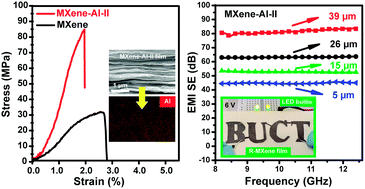Electrically conductive aluminum ion-reinforced MXene films for efficient electromagnetic interference shielding†
Abstract
High-performance and flexible electrically conductive materials with satisfactory mechanical strength are vital in shielding electromagnetic interference (EMI) and radiation for portable electronics and wearable devices. Two-dimensional transition metal carbides/nitrides (MXenes) with remarkable metallic conductivity are considered as ideal candidates for ultrathin EMI shielding films, but their poor mechanical performances often impede their practical applications. Herein, we fabricate highly conductive MXene-based films with remarkable EMI shielding performance and excellent mechanical strength by enhancing the interfacial adhesion among the adjacent MXene nanosheets with multivalent aluminum ions. The tensile strength of the MXene film is significantly enhanced by 190% from 28.7 to 83.2 MPa with the introduction of aluminum ions and its conductivity is retained at 265 600 S m−1, exhibiting superior comprehensive performances to the previously reported results with other reinforcements. The strong and highly conductive MXene film with a small thickness of 39 μm exhibits one of the highest EMI shielding performances of over 80 dB in the X-band. This work provides a simple and efficient strategy for designing and fabricating high-performance MXene-based materials for efficient EMI shielding applications.



 Please wait while we load your content...
Please wait while we load your content...